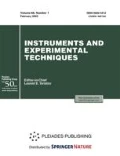Abstract
An ultrashort pulse laser is being used at the Schlesinger center for compact accelerators in Ariel University. The pulse duration ranges from 10 ps to 35 fs and can be varied using a grating, controlled by a remote control. However, there is no real-time indication of its duration while changing the grating position. This laser hits a copper cathode which results in ejection of electrons that serve as free electrons for a THz free electron laser (FEL). Extracting electrons from a copper cathode requires more energetic photons than IR, and therefore the laser’s frequency is tripled (from 800 to 266 nm) using non-linear crystals. The conversion efficiency of the third harmonic generation setup is greater for pulses shorter than 50 fs. In order to properly tune the pulse duration a method to measure the pulse duration in real-time is required. Generally, in order to measure an event, one should use a shorter event than the one being measured. For ultra-short laser pulses, using shorter events to measure the pulse is impossible. Hence, we use the method of auto-correlation which means we harness the pulse itself in order to measure its duration. We used 3DOptix components to build an autocorrelator setup, resulting with a significantly more compact set-up, and very easy to align. We controlled the measurement by a dedicated software we developed for this purpose. Methods and information of the elements in the autocorrelator system are presented, and the necessary requirements to simplify the alignment and measuring procedures are outlined in this paper.




Similar content being viewed by others
REFERENCES
Astrella, Ultrafast Laser System by Coherent. https://www.coherent.com/lasers/laser/astrella-ultrafast-tisapphire-amplifier.
Nause, A., Proc. Int. Particle Accelerator Conference IPAC19, Melbourne, 2019. https://doi.org/10.18429/JACoW-IPAC2019-TUXXPLM3.
Rulliére, C., Femtosecond Laser Pulses: Principles and Experiments, New York: Springer Science + Business Media, 2005. https://doi.org/10.1007/b137908
Terbino, R., Frequency-Resolved Optical Gating: The Measurement of Ultrashort Laser Pulses, Boston, MA: Academic, 2000. https://doi.org/10.1007/978-1-4615-1181-6.
Diels, J.-C.M. and Rudolph, W., Ultrashort Laser Pulse Phenomena: Fundamentals, Techniques, and Applications on a Femtosecond Time Scale, Elsevier, 2006. https://doi.org/10.1016/B978-0-12-215493-5.X5000-9
Thorlabs, 1999. https://www.thorlabs.com.
3DOptix. https://3doptix.com.
Labview, National Instruments. http://www.ni.com/en-il.html.
Diels, J.-C.M., Fontaine, J.J., McMichael, I.C., and Simoni, F., Appl. Opt., 1985, vol. 24, no. 9, p. 1270. https://doi.org/10.1364/AO.24.001270
Group Velocity Dispersion, RP Photonics Encyclopedia. https://www.rp-photonics.com/group_velocity_dispersion.html.
Author information
Authors and Affiliations
Corresponding author
Rights and permissions
About this article
Cite this article
Farag, A., Nause, A. Automated, Convenient and Compact Auto-correlation Measurement for an Ultra-fast Laser Pulse. Instrum Exp Tech 63, 547–550 (2020). https://doi.org/10.1134/S0020441220040028
Received:
Revised:
Accepted:
Published:
Issue Date:
DOI: https://doi.org/10.1134/S0020441220040028



